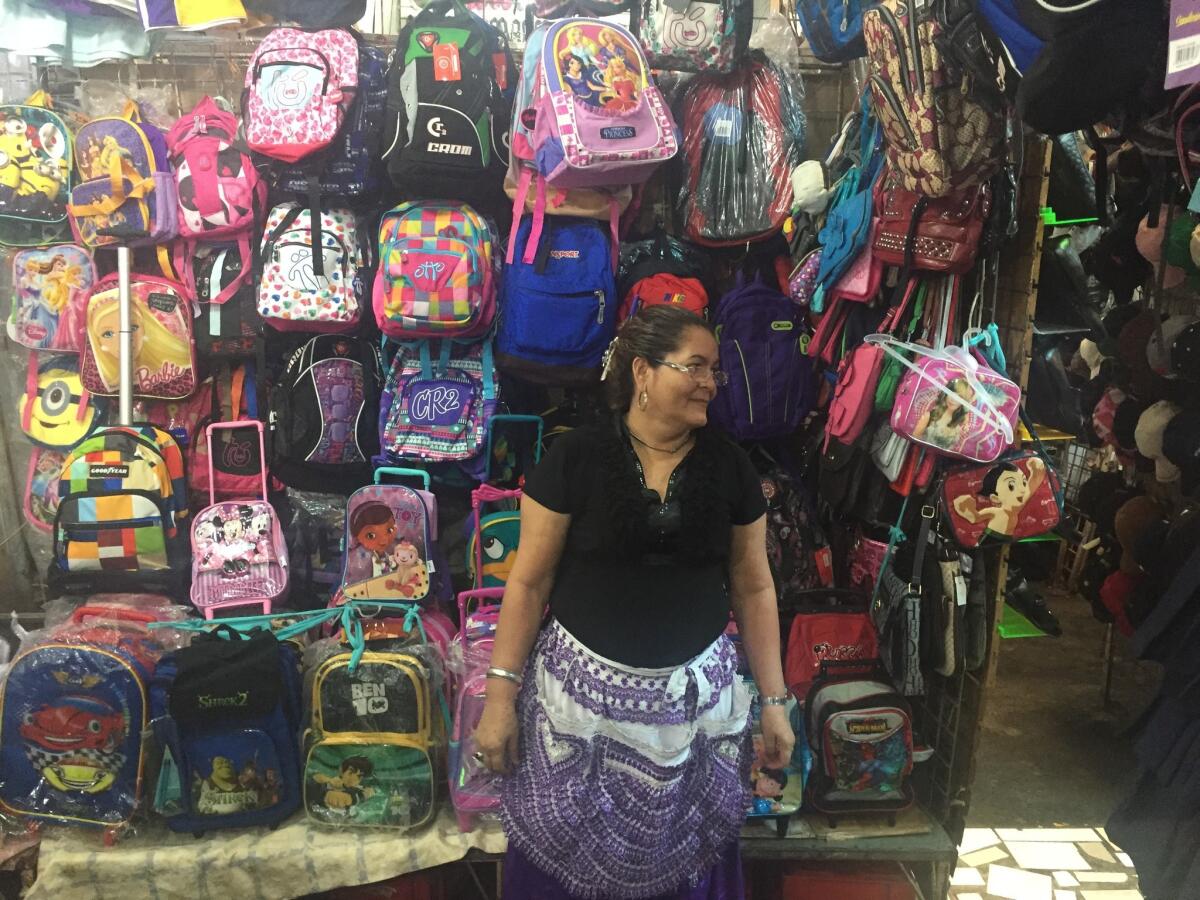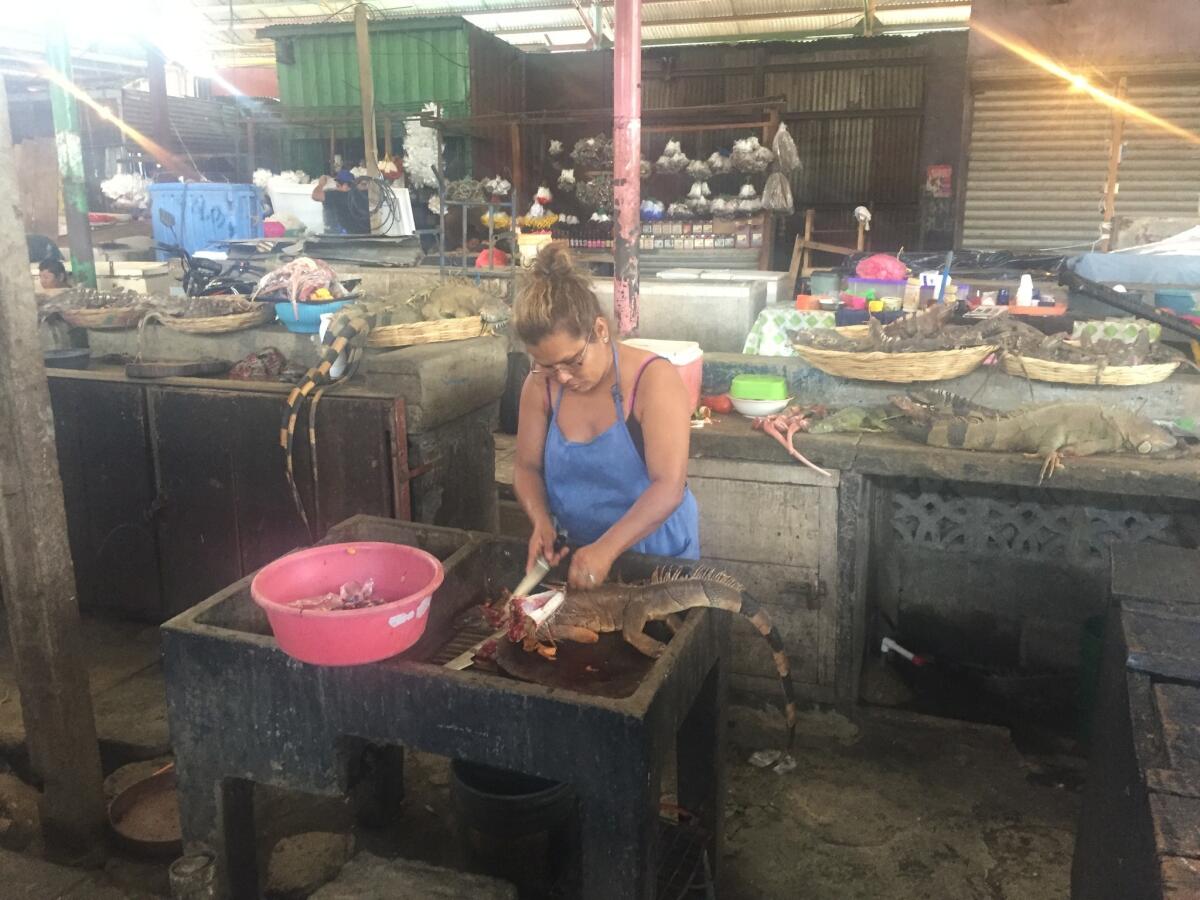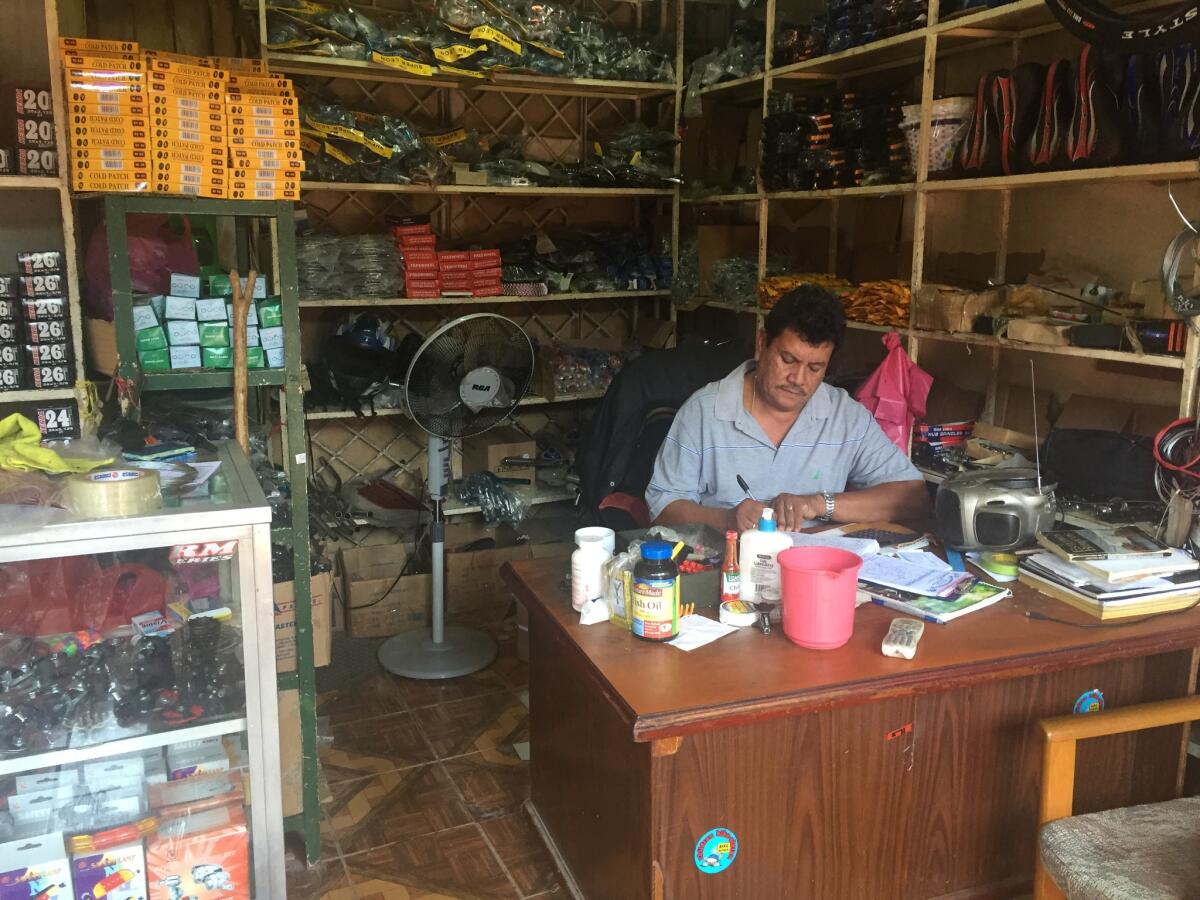Seeking bargains, and hope, at the market swallowing Nicaragua’s capital bit by bit

Victoria Espinal has worked in Nicaragua’s vast Mercado Oriental for 26 years, selling backpacks and clothes. There are days when she doesn’t make any money. “That’s how it is,” she said.
- Share via
Reporting from Managua, Nicaragua — For years Oscar Arrechavala watched as the monster known as Mercado Oriental nibbled on the edges of his neighborhood.
Arrechavala could do nothing as the ever-growing, 130-block marketplace began to claim his barrio of Ciudad Jardin, leaving its people with a choice: Sell their homes to escape the market or learn to live surrounded by a throbbing complex of stalls, vendors and thousands of shoppers.
The 85-year-old Arrechavala stayed, adding tall metal bars to a gate guarding his modest house after someone climbed into his driveway and stole the tires off his car.
No authority, not even the police or the city, has been able to bring order to the market.
— Roberto Sanchez Ramirez, Nicaraguan historian
His street has for the moment avoided the fate of others nearby, but vendors now hawk their wares just a block away. In the war pitting Ciudad Jardin against the mercado, he has no doubt about the eventual outcome.
“The market comes in a little more every day,” he said, resigned. “I don’t know where it’s going to end up. It’s the most disastrous market that exists.”
In a continent known for its free-form, if not haphazard markets, Mercado Oriental seems unrivaled. The market has no single owner, no governing body. Thousands of merchants operate out of metal sheds, stands covered with tarps or umbrellas, or in former houses, though some homes have been bulldozed to make way for more sellers.
Every day it seems, new vendors claim new spaces, spilling over sidewalks and into streets without regulation and helping the market swallow Managua piece by piece.
“It’s a market that grew in a spontaneous way, in complete disorder. ... It’s a disaster,” said Roberto Sanchez Ramirez, a Nicaraguan historian. “There is no comparison. Not in size or in physical characteristic.”

A young woman skins an iguana at her family’s stand in the Mercado Oriental in Managua, Nicaragua.
In Nicaragua there is a saying: La necesidad tiene cara de perro. Necessity has the face of a dog. And like the hundreds of stray dogs that roam the streets of the Nicaraguan capital, always in search of their next meal, many of the country’s poor are constantly hunting for a way to feed themselves and those they love.
And so they come to the mercado, an estimated 100,000 customers each day.
In a country with pervasive poverty, the market attracts residents looking for products on the cheap. In a shopping center, a pair of pants can cost $30 or more. In Mercado Oriental, it goes for around $15. At the mercado, pork tenderloin costs 70 cordobas a pound versus 90 cordobas at the supermarket. Melons are cheaper too: 20 cordobas here compared to 30 cordobas in the supermarket.
“The rich don’t come in here,” said Victoria Espinal, as she organized wheeled backpacks decorated with Snoopy and Disney princesses in her shop also stuffed with bras, shirts, shoes and backpacks. “They have their nice Mercedes and stay in the stores. Poor people come to the mercado.”
One weekday, even before dawn broke, the market was alive, customers navigating dark streets with flashlights, laborers toting baskets brimming with bananas and apples. Vendors advised customers to buy perishables quickly, before supplies dwindled and prices rose.
In the midst of the clamor, a middle-aged security guard stood alone, a machete in a black sheath hanging from his waist.
The rich don’t come in here. They have their nice Mercedes and stay in the stores. Poor people come to the mercado.
— Victoria Espinal, Mercado Oriental merchant
Within its vast bounds the market contains an underlying danger: robberies, prostitution, drugs and even the occasional homicide are part of life. (A few years ago there was a double homicide in the piñata section.) In some of the most perilous areas, including its callejon de la muerte — alley of death — security guards paid by the vendors and customers enforce a semblance of law and order.
“No authority, not even the police or the city, has been able to bring order to the market,” Ramirez said. “I don’t see a solution.”
Still, more and more vendors come.
“People find a chance in here to work, survive and to help provide for their children,” said Jorge Rojas Lopez, as he supervised two workers in his bicycle shop, tires suspended overhead and pink bicycle seats on the shelves behind him. “It’s a struggle, a war, to get ahead.”
The 58-year-old considers how much longer he will work in the market: “Until I die,” he said wryly.
Mercado Oriental was born more than 70 years ago, fewer than four square blocks. Inside, there are now restaurants, barber shops, a medical office and a child development center. The destruction of other Managua markets after a powerful earthquake in 1972 spared the mercado and, with competitors removed, the market continued to grow, said Ramirez, the historian.
An estimated 20,000 merchants routinely work inside the market, but the actual number of vendors could approach 70,000 because multiple families sometimes sell from the same stall, said Augusto Rivera, general manager of the municipal corporation of Managua markets.

Jorge Rojas Lopez, 58, runs a bicycle shop within the Mercado Oriental. He said he believes he’ll work in the market until he dies.
The agency is tasked with regulating eight markets in the capital. Workers collect taxes from vendors and clean inside the markets.
“The Mercado Oriental is like a miniature country,” Rivera said. Every month, merchant sales total at least 2 billion cordobas, or $71 million. Of that the city agency receives 2 million to 3 million cordobas monthly from vendors (about $100,000).
Inside the market is a world redolent of smells from fish, meat, spices and the garbage. Customers shop unfazed, accustomed by now to the overwhelming smell and sounds that pervade the market.
“Espiritu Santo, ayudame te pido,” a singer pleads from the radio, asking the Holy Spirit for help.
But even the singer’s pleas can’t drown out vendors, who call out from behind tables, shopping carts or stands they’ve fashioned out of scraps of wood.
“Que están buscando?” they shout, offering up purses and jewelry to passing women. “What are you looking for?”
Children barefoot and in diapers walk through the streets and alleyways, stepping in puddles and on discarded lunch plates. Stray dogs roam everywhere. School-age children sit on bags of rice, painstakingly doing homework, as their parents work nearby.
Margarita Juarez began selling clothes in the market with her husband 32 years ago. With no jobs in her hometown, she had no choice but to leave for the market.
“I was told to come and that my life would change. So I came,” Juarez said.
She sometimes made just enough money to feed her children — four sons and two daughters. They are now grown and sell clothes like her, each with their own stall.
Eight groups of security guards patrol the market. Carlos Barberena, who began working security at the mercado 12 years ago, walked briskly through the tight alleys and streets packed with men and women pushing carts laden with mandarins, Little Mermaid dolls, and Coke.
He bragged about knowing “this place like the palm of my hand” as merchants called out to him: “Comandante!” A pushcart nearly ran over his feet as Barberena walked confidently through the market unarmed, unlike the guards carrying machetes.
In the so-called alley of death, mujeres de la vida — prostitutes – sat on plastic chairs outside of shacks, dressed in short skirts and wedges. One woman tended a bed inside one room after a customer left. All wore heavy makeup.
Barberena greeted the women with a polite “buenos dias” as he walked by, careful not to linger or interrupt the woman holding a clipboard who seemed to be in charge. None of the women smiled.
Guards have been beaten up and stabbed inside the market. But Barberena said that overall it’s much safer than it used to be.
Still, it’s best to be careful, as one 17-year-old guard, Bayron Jose, tried to be one afternoon as he walked along the border of the alley of death. Carrying a baton and handcuffs, he weighed crossing the threshold into one of the darker corners of Mercado Oriental.
Instead, he turned back.
Follow @brittny_mejia on Twitter.
More to Read
Sign up for Essential California
The most important California stories and recommendations in your inbox every morning.
You may occasionally receive promotional content from the Los Angeles Times.











